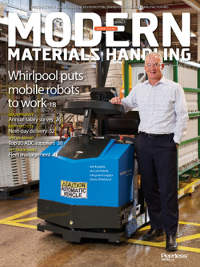System Report: Whirlpool puts mobile robots to work
In Whirlpool Corp.’s Clyde, Ohio, factory, mobile robots have automated the delivery of parts to the line. The result is a more consistent, efficient and safer operation.
Latest Material Handling News
Walmart deploying autonomous lift trucks at four of its high-tech DCs 2024 Intralogistics Robotics Survey: Robot demand surges Autonomous mobile robots (AMRs) on a mission Up close and personal with mind twisting special purpose robots Gartner foresees sizeable uptake for next-gen humanoid robots More RoboticsAt Whirlpool Corporation‘s 2.4-million-square-foot plant in Clyde, Ohio, a fleet of 54 blue robotic tuggers wind their way around the floor, automatically delivering parts every 20 to 30 minutes to some 24 drop-off locations on the assembly and sub-assembly lines.
Operating in a three-shift, five-day-a-week operating environment, the mobile robots are a key component in the lean and continuous improvement philosophy in Clyde—billed as the world’s largest plant manufacturing top- and front-load washing machines. They are also an illustration of the company’s “smart automation” strategy, explains Jim Keppler, vice president of integrated supply chain and quality for the Benton Harbor, Mich., appliance manufacturer. “As a company, we’ve challenged our manufacturing plants to look for opportunities to implement smart automation,” Keppler says. “There is always a labor savings associated with automation, but we are also looking for smart ways to improve safety, quality and speed.” 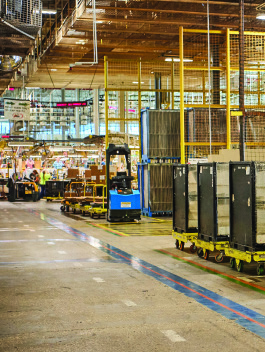
Going from a pilot to a live operation in 2015, the plant has been running with more than 50 vehicles (Seegrid) for a little over a year. While the robotic tuggers did replace manually operated vehicles, Keppler downplays labor savings as a key benefit, largely because operators were offered other jobs within the plant. Rather, the tuggers are contributing to a safer working environment, as Whirlpool strives to create more fork-free work areas, while mitigating the risk to throughput from an inability of drivers to keep up with the ever-increasing speed of production or a labor shortage.
Local manufacturing
Automation, like robotics, also contributes to the company’s strategy of producing its products near the markets it serves. While the outsourcing of U.S. manufacturing has been in the news in recent years, Whirlpool has taken a different tack by focusing on efforts to keep the manufacturing of its iconic brands whenever possible close to the markets served by its plants including markets in North America. “Eighty percent of what we sell in the United States is produced in the United States,” Keppler says. “We’re very proud of the fact that we’re the only appliance company that never really left the United States.” In fact, Whirlpool operates five manufacturing plants and employs more than 10,000 people in Ohio, including three facilities with more than 2,000 employees. 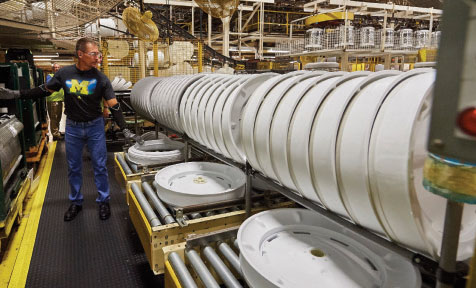
The Clyde plant plays a role in that strategy. Back in December 2013, Whirlpool announced that it was shifting the production of front-loading washing machines used by laundromats and some residential washers sold in Canada from Mexico to Clyde. At the time, the move was expected to add some 80 to 100 production jobs, according to news reports. While wages were lower in Mexico, Whirlpool expected to offset those costs through lower transportation costs, since production would be closer to the markets served; through lower energy costs; and by leveraging automation at Clyde.
“Competition in the appliance industry has accelerated in the last 10 years,” Keppler says. “The consumer is more sophisticated and has a different set of expectations. Speed to market is more important than ever. For us to stay competitive, we have to look for opportunities to neutralize the cost advantages of a low-cost area.”
Getting lean
Automation is one way a manufacturer like Whirlpool can meet that cost challenge. The Clyde facility already had robotic paint lines in operation, and Whirlpool has used traditional automatic guided vehicles (AGVs) in other plants. But, it’s not just automation for the sake of automation; Whirlpool looks for projects that will also improve on other areas of the operation besides just a labor savings. “If we can find ways to generate safety or quality improvements along with labor savings, that’s a win-win scenario,” Keppler says.
The mobile robotic project in Clyde grew out of an ongoing lean initiative to create an efficient and repeatable process to deliver components to the line in a just-in-time basis. When the initiative got underway in 2012, forklifts were delivering pallets of components to the line, which meant both a significant amount of lift truck traffic as well as extra space to accommodate pallets at the line. 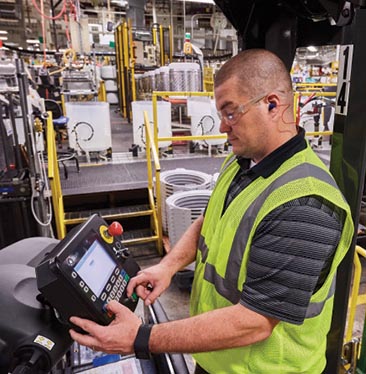
The first step in the lean process was to get rid of the pallets—and, as a consequence, the need for lift trucks. Whirlpool created a “supermarket” area near the storage area for parts and components coming into the plant. Instead of delivering pallet load quantities, parts were kitted into reusable totes and containers that could be delivered by a tugger pulling carts and following established routes. The containers were right-sized so that a delivery occurred every 20 to 30 minutes, depending on the route. “A lot of work went into creating the kitting operation and establishing the routes to deliver just what we needed before we could even think of automation,” Keppler says.
Once the manual process was in place, the next step was to look for a technology that could take operators out of the process by automating delivery. Keppler says that labor is always a consideration, but that in this instance, safety and throughput were the key drivers. “We have a commitment to our employees that they will not lose a job as a result of lean activities,” Keppler says. “They may be moved somewhere else doing a different job, but we will keep them on.”
At the same time, Whirlpool does put a restriction on the number of hours worked to manage overtime and, even the best drivers are sometimes absent, which can impact productivity. “There is no absenteeism and no restrictions on work hours with robotic tuggers,” Keppler says. “And while we have some great drivers following well-established routes, a driver is sometimes stopped or side-tracked on their way to the line. That doesn’t happen with robots.”
Moreover, robotic tuggers, especially in high-traffic areas, were considered safer than operator vehicles. “We want to be 100% forklift free and whenever you have a lot of vehicles operating in a high-velocity operation, there’s a chance for an accident,” Keppler says.
The question was: What type of technology would fit the bill?
Going mobile
The initial thought was traditional AGVs, which Whirlpool has used in other facilities. But traditional AGVs required some kind of an infrastructure for the guidance system, such as tape on the floor or reflectors. At some point, a member of the Clyde materials team saw a story on a mobile robotic solution with a new kind of guidance system. That set off the light bulb. “What is unique about this technology is that it has cameras mounted on the robot to map the facility,” Keppler explains. “You walk it along, and it learns the paths. It also has sensors that know whether it is on a collision course with a person or another piece of materials handling equipment and can automatically stop to avoid those accidents.”
While the technological advantages were attractive, the unknown was whether the robotic tuggers were robust enough to keep up in a high-velocity, three-shift production environment. “I can’t stress enough the importance of having a consistent and repeatable process,” Keppler says.
In 2013, Whirlpool made the decision to move forward with a pilot involving three units on one assembly line in the three-shift environment. Ultimately, the pilot lasted for nearly a year and the vehicles were put to the test in different areas along multiple lines. As with the original process, during the pilot the tuggers were manually loaded with kitted materials in returnable containers in the supermarket. They then traveled a specific route to a designated drop-off point, where an operator unloaded a cart and then loaded on the empty containers. After all the carts had been unloaded, the tugger returned to the supermarket for the next load. While all of the routes were loaded into each tugger’s operating system, making them available for any route, as a rule a tugger traveled the same route for a shift, according to Keppler.
At the end of the pilot, Whirlpool was convinced that the tuggers could keep up with the throughput demands of the facility; moreover, they proved to be more consistent on their routes than drivers and provided needed flexibility because there were no restrictions on their work hours. Most importantly, they created a safer work environment. “At that point, we talked to our supplier about a plan to expand the number of mobile robots,” Keppler says. “We moved from one assembly line to another until today. We have a total of 54 vehicles covering all of our assembly lines and some support lines.”
Lessons learned
The full fleet of robotic tuggers has been in operation in Clyde for a little more than a year. During that time, Keppler says they have made several improvements and learned a few lessons.
The first lesson was the importance of change management to allay the concerns of employees. Automation is not new to Clyde, but this was the first foray into this type of technology. “We reinforced our commitment that no one would lose a job as a result of a lean activity,” Keppler says. “We also reinforced the benefits to the Clyde location and safety was the biggest benefit we could highlight for our employees. Even operator-driven tuggers can have accidents. The robots have all kinds of redundant technologies so that it’s almost impossible to have an accident.” 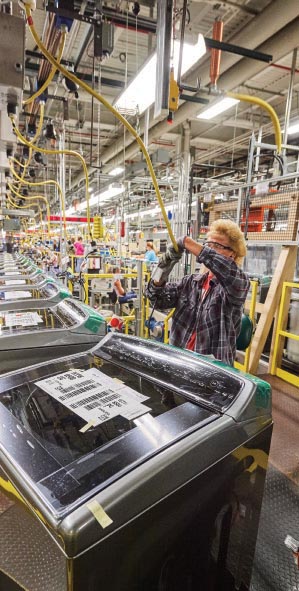
A second lesson was that longer runs yield more benefits than short runs. Activities like returning empty containers to the supermarket constitute non-value-added travel. Having mobile robots make those runs is more efficient, and the efficiencies multiply over longer runs.
A third was that more planning was required to accommodate a fleet of more than 50 vehicles. “We had to really plan out the routes and then time them so there wouldn’t be interferences or collisions,” Keppler says. One change was to create multiple pickup points rather than using just the supermarket to pick up kitted material. Whirlpool also implemented a supervisory control system from the supplier that monitors the movement of the tuggers through the facility and controls the intersection points, minimizing the chance of a collision.
Last, Whirlpool added a status screen at the workstation that lets the operator know when the next cart will be coming down the aisle and whether it will be on time.
A fourth lesson was that wider aisles are better than narrow aisles. “One thing we didn’t fully realize until we had a large fleet operating is that you want to have wide aisles to accommodate the mobile tuggers and any other traffic,” Keppler says. “Not all of our facilities have those.”
Looking forward, Keppler says automation will provide a measure of protection in a tightening job market. “When we began working on this in 2013, there wasn’t as big of a labor shortage for us in Ohio,” he says. “But with the unemployment rate dropping, automation is a hedge if that situation comes about in the future.”
What’s more, he adds, Whirlpool is looking to extend the capabilities of the process through an automatic unloading process at the workstations. “We’re working in-house on technology to automatically load and unload carts at the line,” Keppler says. “We’ve asked our supplier to develop a reverse function for the tuggers. That would give us the ability to have the robot drop off the loaded carts, then back up and hook up to a train of empty containers.”
Last, the project in Clyde is proving to be a test bed for this type of technology that can now be extended into other facilities, as those plants are ready. “Solutions like this are critical to our commitment to U.S. manufacturing,” Keppler says. “As the technology continues to improve and change, you’re going to see us continue implementing it in our plants.

Article Topics
Robotics News & Resources
Walmart deploying autonomous lift trucks at four of its high-tech DCs 2024 Intralogistics Robotics Survey: Robot demand surges Autonomous mobile robots (AMRs) on a mission Up close and personal with mind twisting special purpose robots Gartner foresees sizeable uptake for next-gen humanoid robots A3 bestows Joseph F. Engelberger Robotics Awards to three industry leaders Agility Robotics and Manhattan Associates partner to bring AI-powered humanoid robots into warehouses More RoboticsLatest in Materials Handling
Lucas Watson appointed CSO for Körber’s Parcel Logistics business in North America Hyster recognizes Dealers of Distinction for 2023 Carolina Handling names Joe Perkins as COO C-suite Interview with Keith Moore, CEO, AutoScheduler.AI: MODEX was a meeting place for innovation Walmart deploying autonomous lift trucks at four of its high-tech DCs Coles shops big for automation Kathleen Phelps to join FORTNA as chief financial officer More Materials HandlingAbout the Author
Subscribe to Materials Handling Magazine

Find out what the world's most innovative companies are doing to improve productivity in their plants and distribution centers.
Start your FREE subscription today.
April 2024 Modern Materials Handling

Latest Resources


